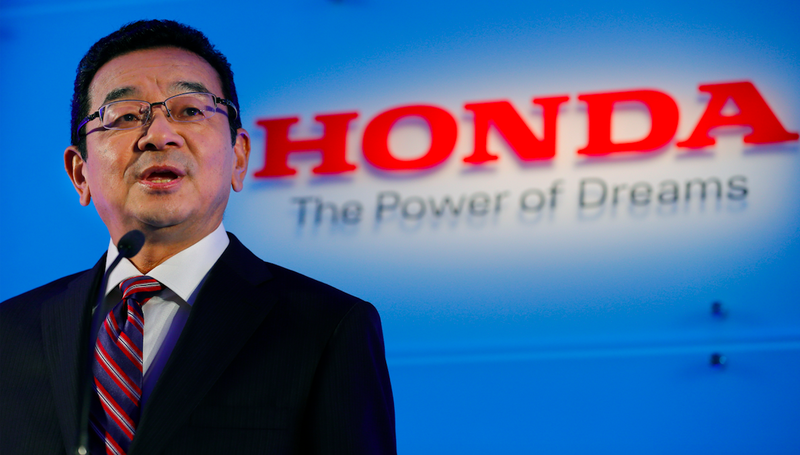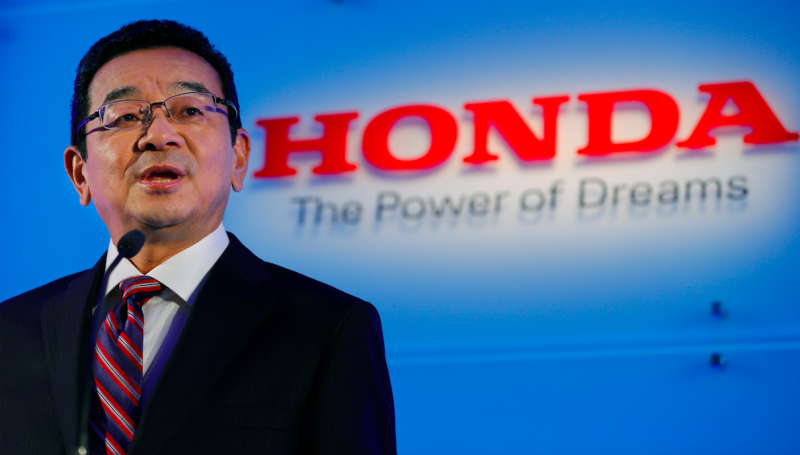
Honda’s been missing the mark over the past few years. The CR-Z was slow and expensive, the Insight was so bad Honda decided not to make another one, and the Civic Si has become a shadow of its former self. To get Honda on the right path, Business Insiderreports that Honda’s new CEO, a former engineer, is giving the power back to the tech nerds.
Takahiro Hachigo, CEO of Honda, has only been at his post for a year, and now he’s ready to make some big changes to the way his company functions. In particular, he thinks Honda’s woes have been caused by the classic “too many cooks in the kitchen” syndrome, as BI’s Honda insiders explain:
Over the years, our product development process became overly complex and slow, involving a huge number of engineers and sales and marketing people…. [and] we began producing watered down, uninspiring, what you might call designed-by-committee, cars.
To fix their problem and make their development process more efficient, Honda will “reduce the influence of sales and marketing teams on car design,” because sales people tend to “focus more on a car’s affordability than its performance.” They also tend to want to sell a car that people already want, but, as Henry Ford may not have actually said, “if I asked people what they wanted, they would have asked for a faster horse.”
Advertisement
To reduce sales’s role in the auto development process, Hachigo may uninvite sales executives from key product planning meetings, a move that could make things a bit awkward in Honda land, as we all know uninviting people from parties they’re already invited to is the social equivalent of stabbing someone in the eyes with a fork.
But that’s not all, as senior engineers may be moved from the Tokyo head office, where they currently sit to better communicate with sales divisions, to Honda’s tech center. The Honda executives went on to say that “tech people should design cars more freely, but take responsibility if the car isn’t successful.”
Sponsored
The goal of Hachigo’s reorganization is to ultimately boost sales by building better cars. Which sounds good to us.
So Honda’s giving engineers free reign; that will lead to more exciting cars and solve all their problems, right? As a former automotive engineer, I’m not so sure. Part of the issue is that half the reason cars are watered down is because of the engineers.
Don’t get me wrong, I’ve been to meetings where purchasing and sales guys have flat-out told me “sorry, we can’t put that [insert extremely cool and innovative feature] into the car because it costs a couple dollars too much.”
I’ve then had those same people tell me “this is part of the Consumer Reports criteria, so we need to add this [insert stupid, useless, compromised feature] to the car.” The end result is something that meets lots of Consumer Reports-like criteria, but isn’t remotely interesting or forward-thinking from a technical standpoint.
Advertisement
But that kind of compartmentalized thinking isn’t unique to sales and marketing folks. Engineers are among the worst offenders. A dynamics engineer might, in an effort to meet corporate handling targets, suggest that the Wrangler should get independent front suspension. An aerodynamics engineer might suggest a ride-height reduction and a more raked windshield to meet aero targets, and anoise, vibration, and harshness engineer might suggest lots of sound deadening.
What you end up with is a car like the new Jeep Cherokee. It’s okay off-road, it’s okay on the highway, it’s okay in the turns. But it doesn’t have the soul of a Wrangler.
And that’s the issue when you’ve got too many cooks in the kitchen; everyone is trying to meet their own internal targets. Sales guys need to save a buck, marketing guys basically want to use Consumer Reports as a cheat sheet, and engineers want to optimize their individual systems or components.
And if you don’t clearly define what the car has to be, and where each group should be willing to make sacrifices, you wind up with a car like the Pontiac Aztek, a car that checks all the boxes, but when you stand back and look at it, you realize you’ve just created a car with absolutely no emotional appeal.
A similar thing happened with the 2012 Honda Civic, which clearly had too much input from sales guys trying to maximize profit, as the car was cheap, the interior quality was poor, the ride quality was bad and that all-too important noise, vibration, and harshness was unacceptable. For the first time, Honda had built a Civic that was truly compromised and significantly worse than its predecessor.
But that’s not to say Honda’s strategy won’t work, especially since Honda isn’t likely to truly give their engineers “free reign.” So long as they give engineers a clear picture of what the car has to be, let them design within those boundaries and then let the sales guys in after designs have been optimized, this might be a good call.
After all, fewer cooks in the kitchen usually results in a more focused product.













